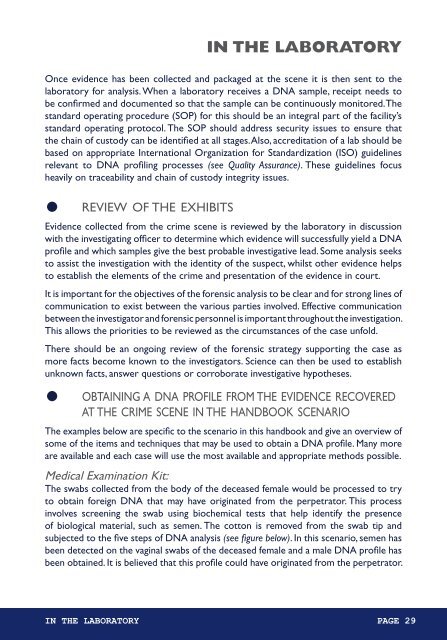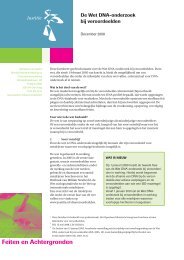INTERPOL HANDBOOK ON DNA DATA EXCHANGE AND PRACTICE
INTERPOL HANDBOOK ON DNA DATA EXCHANGE AND PRACTICE
INTERPOL HANDBOOK ON DNA DATA EXCHANGE AND PRACTICE
You also want an ePaper? Increase the reach of your titles
YUMPU automatically turns print PDFs into web optimized ePapers that Google loves.
IN THE LABORATORYOnce evidence has been collected and packaged at the scene it is then sent to thelaboratory for analysis. When a laboratory receives a <strong>DNA</strong> sample, receipt needs tobe confirmed and documented so that the sample can be continuously monitored. Thestandard operating procedure (SOP) for this should be an integral part of the facility’sstandard operating protocol. The SOP should address security issues to ensure thatthe chain of custody can be identified at all stages. Also, accreditation of a lab should bebased on appropriate International Organization for Standardization (ISO) guidelinesrelevant to <strong>DNA</strong> profiling processes (see Quality Assurance). These guidelines focusheavily on traceability and chain of custody integrity issues.•review of the exhibitsEvidence collected from the crime scene is reviewed by the laboratory in discussionwith the investigating officer to determine which evidence will successfully yield a <strong>DNA</strong>profile and which samples give the best probable investigative lead. Some analysis seeksto assist the investigation with the identity of the suspect, whilst other evidence helpsto establish the elements of the crime and presentation of the evidence in court.It is important for the objectives of the forensic analysis to be clear and for strong lines ofcommunication to exist between the various parties involved. Effective communicationbetween the investigator and forensic personnel is important throughout the investigation.This allows the priorities to be reviewed as the circumstances of the case unfold.There should be an ongoing review of the forensic strategy supporting the case asmore facts become known to the investigators. Science can then be used to establishunknown facts, answer questions or corroborate investigative hypotheses.•obtaining a dna profile from the evidence recoveredat the crime scene in the handbook scenarioThe examples below are specific to the scenario in this handbook and give an overview ofsome of the items and techniques that may be used to obtain a <strong>DNA</strong> profile. Many moreare available and each case will use the most available and appropriate methods possible.Medical Examination Kit:The swabs collected from the body of the deceased female would be processed to tryto obtain foreign <strong>DNA</strong> that may have originated from the perpetrator. This processinvolves screening the swab using biochemical tests that help identify the presenceof biological material, such as semen. The cotton is removed from the swab tip andsubjected to the five steps of <strong>DNA</strong> analysis (see figure below). In this scenario, semen hasbeen detected on the vaginal swabs of the deceased female and a male <strong>DNA</strong> profile hasbeen obtained. It is believed that this profile could have originated from the perpetrator.IN THE LABORATORY PAGE 29







